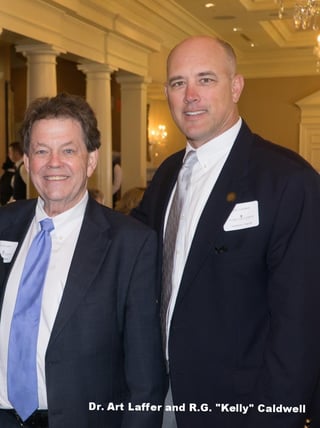 Once again, we had the opportunity to attend Dr. Art Laffer’s conference in Washington D.C. and we will save you the suspense on the political atmosphere in Washington. The only bipartisan consensus we observed happened when it was announced that a Special Counsel had been appointed to investigate Russian interference in the 2016 election. Support for the move by the Justice Department came from both sides of the aisle. Little agreement and a lot of contention was evident for the balance of the conference that focused on presentations by numerous representatives and senators, as well as Vice President Pence and Office of Management and Budget Director Mulvaney.
Once again, we had the opportunity to attend Dr. Art Laffer’s conference in Washington D.C. and we will save you the suspense on the political atmosphere in Washington. The only bipartisan consensus we observed happened when it was announced that a Special Counsel had been appointed to investigate Russian interference in the 2016 election. Support for the move by the Justice Department came from both sides of the aisle. Little agreement and a lot of contention was evident for the balance of the conference that focused on presentations by numerous representatives and senators, as well as Vice President Pence and Office of Management and Budget Director Mulvaney.
Economic growth is the number one focus of the Administration and the GOP-led Congress. Their stated goal for GDP growth is 3%, which is markedly higher than the average of 1.9% since the turn of the century but lower than the post-World War II average of 3.22%. The consensus on how to reach this goal is through tax reform, deregulation, and rebuilding our infrastructure and the military. Though opinions differed on each of these topics, there was a belief that making changes in these areas would lead to improved economic growth. Here at Caldwell Trust Company we believe pro-growth policies can lead to higher equity markets as we referenced in our recent blog: Why We Endorse Pro Growth Policies.
Tax Reform
The Administration has proposed tax reform, which they believe needs to be permanent, significant and simple. They concede this model will create short term deficits but believe deficits will diminish as the lower tax rates allow the economy to grow at a faster pace, which in turn produces higher tax revenues. But in order to offset some of the initial deficit created there was discussion of adding a Border Adjustment Tax (BAT) or a Carbon Tax. The BAT tax is part of the House’s tax bill but, there was no support from the Senators we heard from. The key components that were discussed on tax reform:
Corporate Taxes:
- Reduce corporate rates from 35% to 15%-20%
- Include pass-through entities (S Corps, Partnerships etc.)
- Repatriate domestic corporations’ offshore profits via a one-time reduced corporate income tax
Individual Taxes:
- Reduce and flatten personal tax rates to 10%, 15% and 20%
- Terminate the Federal Estate Tax and the Alternative Minimum Tax (AMT)
- Others discussed: eliminate state income tax deduction and mortgage interest deduction
The overall discussion on tax reform was positive, and most everyone we heard from believed that tax reform has a better than 50% chance of being passed before yearend. However, if no bill is passed by yearend then the chance of something happening before the mid-term election is greatly diminished.
Healthcare and Deregulation
On health care reform, there were 2 major takeaways:
- The current system put in place under the Affordable Care Act is failing quickly as most insurers are pulling out of states as their costs rise.
- The ACA only covers about 6% of the population, commonly referred to as the individual market. The balance is covered through Medicare, Medicaid and employer plans.
The Administration’s focus on health care is on the individual marketplace being able to buy health insurance across state lines and providing block grants to states on Medicare. Like tax reform legislation there were differing opinions and much speculation about the timing of final legislation and whether it would occur prior to yearend.
Other Observations
Other observations we found interesting include the comment that the average student loan debt for those graduated from college is $29,000. We found this number rather reasonable and at odds with the popular perception that kids were coming out of college with unmanageable debt loads. The other observation is that while progress on tax and health care reform is challenged, the administration has been very active on regulatory reform and has pushed back or eliminated via executive order billions of dollars in government regulation.
Also, a presentation was made that looked at domestic demographics which pointed out that what was once a pyramid (fewer older folks at the top supported by a broader younger base) is turning into a cylinder. This change portends challenges from an economic growth mindset, as the prevailing thinking from an economics perspective is that population and productivity growth drive economic activity. It also explains the increasing burden of Social Security and other entitlement obligations in the U.S.
What We Didn’t Hear
With all the focus on economic growth and deregulation we were surprised that not one elected official addressed the 800-pound gorilla in the room, entitlement spending. The members of Congress we heard from regarding spending cuts only focused on discretionary spending which accounts for 1/3 of the federal budget. The majority, or 2/3 of the current budget, is comprised of entitlements. A budget was not passed under the previous Administration, and these expenditures have been on auto-pilot, increasing every year with no end in sight. As one economist put it, “if left on auto-pilot we will be the next Greece.”
Conclusion
In conclusion, we heard that the common goal is to ignite economic growth. This could ultimately enable the country to meet its growing obligations and position itself well for the future. Democracy is a notoriously slow and messy form of government as evidenced by the controversy surrounding tax and health care reform and the budget. Compromise from both parties will be needed for progress on any of the proposed changes, and if that happens we could see some form of pro-growth policy start to take shape by year end.










